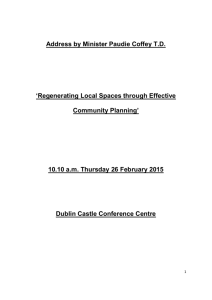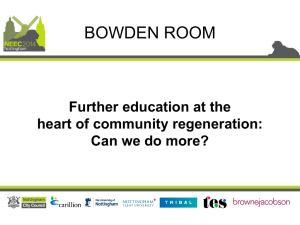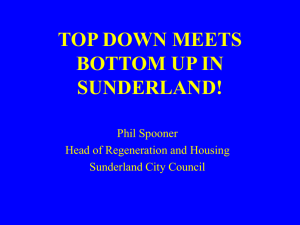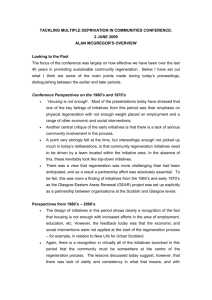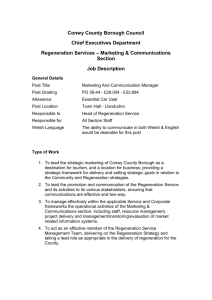Document 10464633
advertisement
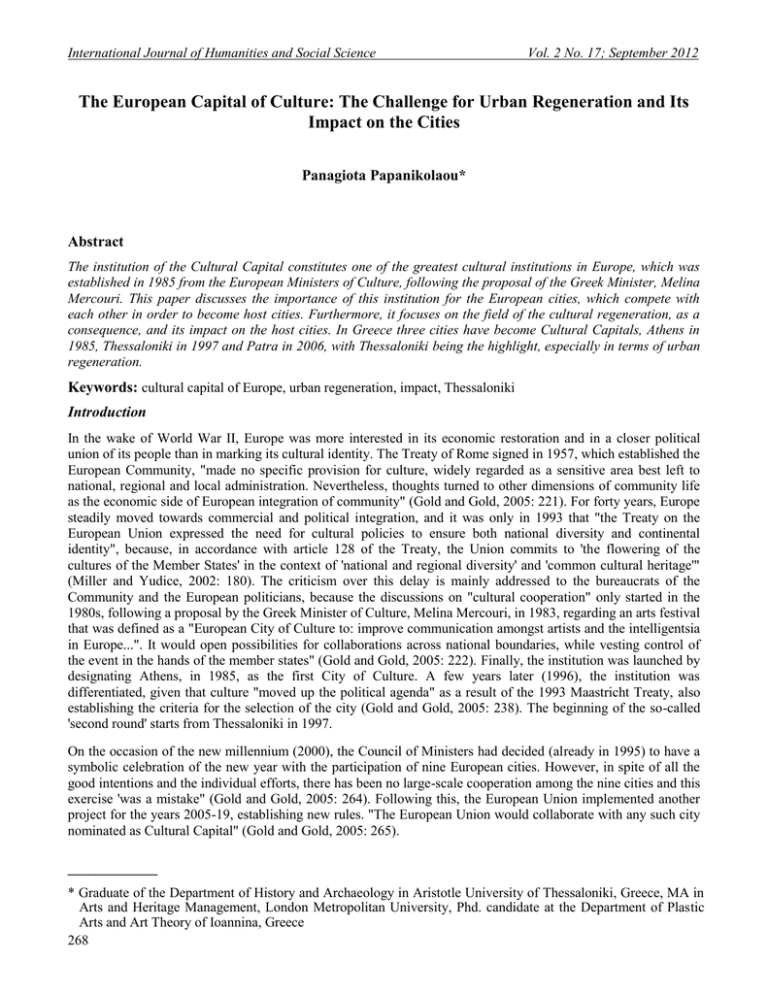
International Journal of Humanities and Social Science Vol. 2 No. 17; September 2012 The European Capital of Culture: The Challenge for Urban Regeneration and Its Impact on the Cities Panagiota Papanikolaou* Abstract The institution of the Cultural Capital constitutes one of the greatest cultural institutions in Europe, which was established in 1985 from the European Ministers of Culture, following the proposal of the Greek Minister, Melina Mercouri. This paper discusses the importance of this institution for the European cities, which compete with each other in order to become host cities. Furthermore, it focuses on the field of the cultural regeneration, as a consequence, and its impact on the host cities. In Greece three cities have become Cultural Capitals, Athens in 1985, Thessaloniki in 1997 and Patra in 2006, with Thessaloniki being the highlight, especially in terms of urban regeneration. Keywords: cultural capital of Europe, urban regeneration, impact, Thessaloniki Introduction In the wake of World War II, Europe was more interested in its economic restoration and in a closer political union of its people than in marking its cultural identity. The Treaty of Rome signed in 1957, which established the European Community, "made no specific provision for culture, widely regarded as a sensitive area best left to national, regional and local administration. Nevertheless, thoughts turned to other dimensions of community life as the economic side of European integration of community" (Gold and Gold, 2005: 221). For forty years, Europe steadily moved towards commercial and political integration, and it was only in 1993 that "the Treaty on the European Union expressed the need for cultural policies to ensure both national diversity and continental identity", because, in accordance with article 128 of the Treaty, the Union commits to 'the flowering of the cultures of the Member States' in the context of 'national and regional diversity' and 'common cultural heritage'" (Miller and Yudice, 2002: 180). The criticism over this delay is mainly addressed to the bureaucrats of the Community and the European politicians, because the discussions on "cultural cooperation" only started in the 1980s, following a proposal by the Greek Minister of Culture, Melina Mercouri, in 1983, regarding an arts festival that was defined as a "European City of Culture to: improve communication amongst artists and the intelligentsia in Europe...". It would open possibilities for collaborations across national boundaries, while vesting control of the event in the hands of the member states" (Gold and Gold, 2005: 222). Finally, the institution was launched by designating Athens, in 1985, as the first City of Culture. A few years later (1996), the institution was differentiated, given that culture "moved up the political agenda" as a result of the 1993 Maastricht Treaty, also establishing the criteria for the selection of the city (Gold and Gold, 2005: 238). The beginning of the so-called 'second round' starts from Thessaloniki in 1997. On the occasion of the new millennium (2000), the Council of Ministers had decided (already in 1995) to have a symbolic celebration of the new year with the participation of nine European cities. However, in spite of all the good intentions and the individual efforts, there has been no large-scale cooperation among the nine cities and this exercise 'was a mistake" (Gold and Gold, 2005: 264). Following this, the European Union implemented another project for the years 2005-19, establishing new rules. "The European Union would collaborate with any such city nominated as Cultural Capital" (Gold and Gold, 2005: 265). _____________ * Graduate of the Department of History and Archaeology in Aristotle University of Thessaloniki, Greece, MA in Arts and Heritage Management, London Metropolitan University, Phd. candidate at the Department of Plastic Arts and Art Theory of Ioannina, Greece 268 © Centre for Promoting Ideas, USA www.ijhssnet.com The competition among the European host cities wishing to integrate the institution of European Capital of Culture demonstrates that the organizing countries use their participation in such events on the basis of a strategy aiming at the economic development of the host-city (Greg and Wilson, 2004: 1931). The participation in this institution (as well as in others, for example the EXPO, the Mundial or the Olympic Games) contributes to showcasing the cultural reserves of a city, since culture is a main resource for the development of tourism and the principal leverage to revive the local economy. In this light, cultural events contribute to enhancing the image and reputation of the city, highlight the creativity of its habitants, give life to the streets and the squares of the city, satisfying the aspirations of the citizens" (Greg and Wilson, 2004: 1932). Culture - said Zukin (1995) - is the "comparative advantage", if seen through a set of creative activities of a city (Greg and Wilson, 2004: 1932). On the other hand, such festivals contribute to the pride of the community and to solidarity (Getz and Frisby, 1991: 38). Furthermore, "in many parts of the world, these provide opportunities for individuals, regardless of class affiliations or social, religious, or economic status, to interact with other community members in unified ways" (Bolin and Dunstan, 1985: 30). Considering that "the image of a place" (Greg and Wilson, 2004: 1933) is very important for attracting visitors, all the efforts undertaken by the organizers converge in carrying out large projects, such as famous museums and international institutions, so that the city itself will become a popular destination and acquire a prominent brand name. A city can acquire 'place branding", provided that all policymaking bodies cooperate and that all data is properly managed (Bianchini and Ghilardi. 2007: 6-7). European Capital of Culture as a mega-event. Aims and objectives According to the European Commission and following its decision to designate Athens as the first European Capital of Culture (1985), the aims of the institution were as follows: "The event was designed to 'help bring the peoples of the member states closer together' through the 'expression of a culture which, in its historical emergence and contemporary development, is characterized by having both common elements and a richness born of diversity"' (Greg and Wilson. 2004: 1936). Over the course of the institution, twenty six year later, many European cities have won the title, each investing in urban regeneration or a policy of economic and cultural development or an effort "to enhance the quality of life of the inhabitants" (Greg and Wilson, 2004: 1937). In 2004, the European Commission codified the aims and objectives of European Cities and Capitals of Culture as follows: "The concept of ECOC is open to a number of interpretations and the main motivations behind the nomination for the ECOC is open title, the key mission and major objectives have varied from city to city. Most cities had multiple objectives, most often referring to the need to raise the international profile of the city and its region, to run a programme of cultural activities and arts events, to attract visitors and to enhance pride and selfconfidence. Other objectives for some cities included expanding the local audience for culture making improvements to cultural infrastructure, developing relationships with other European cities and regions, promoting creativity and innovation and developing the careers/talents of locai artists..."(ECOC, 2004). There are many international festivals and mega-events taking place all over the world, due to the need to promote the important achievements of mankind in all kinds of areas. The results are various: "These can draw in huge tourist revenues and focus international media attention on the host city..." (Gold and Gold, 2010: 272). Evidently, inherent features of marketing represent hallmark events that create opportunities for tourism, showcase national and international features, have an impact on local society, promote culture, and maximize the economic and environmental benefits, always on the basis of proper planning (Deffner and Labrianidis, 2005: 241). The planning of cultural policy requires punctuality in the management of time and space, so that the problems in the construction of large projects can be addressed in an interrelated manner and on the basis of "urban and economic regeneration". Big events contribute to rural and economic regeneration because "culture, space and economy are all interconnected" (Deffner and Labrianidis, 2005: 242 and 244-245). Cultural heritage is the main strong feature of all capitals of culture and is part of the strategic planning lasting for a year and of the proposed projects within this timeframe. Cultural events are of high quality, to the extent that they introduce 'innovation' and 'creativity', including 'new types' of cultural activities and workshops for the creative participation of young people (Deffner and Labrianidis. 2005: 249). The institution of European Capital of Culture is basically a culture festival, which plays an important role in the members' lives of a local community. The organizers are invited to implement a strategic plan of survival and success that will support multiple actions and provide benefits to their area, following the principle that "tourism is one of the structured environment in which culture is embedded. Festivals are situated as attractions in the tourism literature. 269 International Journal of Humanities and Social Science Vol. 2 No. 17; September 2012 Cultural products and institutions generally are like other consumer goods, regardless of the meanings that people attach to them" (Derrett, 2005: 2-3, 5). The impact of cultural festivals on host communities is direct and it is, therefore, necessary to evaluate both the economic impact and the socio-cultural impact, although the most important feature remains the study of the impact of art festivals on local tourism (Small et al., 2005: 66-67). In recent years, due to globalisation that has extended in all parts of the planet, one can note an increased competition among cities, in order for them to stand out and distinguish themselves. Therefore, policy-making in the area of culture has become a major issue. "Festivals and events are an essential part of city life. They have a function of providing a good vehicle to strengthen a city in competition. Given this function, more and more cities hold festivals and events with the aim of improving the cities' images, attracting visitors and investment as well as stimulating urban development and boosting local economy as a whole" (Wang, 2009: 5). Regarding the definition of the terms 'festival' and 'event'(Getz, 1991), which "usually go hand to hand", "a festival is a public themed celebration which is concentrated in time and delivered with a clear purpose" (Wang, 2009: 6-7). In addition, as explained by Janiskee (1980: 97) and quoted by Bernadette Quinn (2009: 5), festivals and events can be understood as "formal periods or programs of pleasurable activities, entertainment, or events having a festive character and publicly celebrating some concept, happening or fact". Large cultural events can transform the image of a city and "have come to be seen as catalysts for urban regeneration" (Garcia, 2004 in Quinn, 2009: 12). Certainly, an important factor is also the yearly duration of the institution of European Capital of Culture (ECOC). In festivals, the arts, such as music, visual arts, drama, dance, cinema as well as other forms of cultural heritage, occupy a prominent position (Wang, 2009: 7). As noted (Hoyle, 2002), "markets continually change, as do their tastes, interests, fads, and priorities. Thus, event marketers should be alerted that there is no guarantee that their events will be always successful, without an effective marketing plan to continually analyze changes in market segments and the direct influence they have on event participation" (Kwak, 2005: 4). In any event, the proper operation of marketing and the responsible management of cultural events will contribute to the success of the institution and to the exploitation of the cultural product. It has also become evident that cultural events and artistic festivals "are now an important and prolific area of tourism" and the interest in them has been of great interest during the last decades not only for tourism literature but also for academic literature, in view of the strategic and operational management of events (Quinn, 2009: 1). In accordance with the criteria established by the European Union on the European Capital of Culture (decision on the European Capital of Culture, 2004, article 4), "candidate cities must present the role they have played in European culture, their links with Europe, their European identity. They must also demonstrate current involvement in European artistic and cultural life, alongside their own specific features". In the same article of the European Commission decision, the relationship between the city and its citizens is specified and, regarding the program, "candidate cities must present a program that anticipates large-scale public involvement at both local and European levels. How can the city attract not only the local and national population, but also tourists from other countries? This criterion is also intended to encourage cities to devise a program with lasting effects, a program which impacts on the long-term development of the city". The impact on urban regeneration On the occasion of the Olympic Games to be held in London in 2012, one of Europe's largest regeneration projects is underway in the area of Lea Valley, in the northeastern part of the city. The Games - as mega-event used "as a vehicle for regeneration of one of the largest areas of brownfield land in the London area" (Gold and Gold, 2010: 278). As expected, the debate on the usefulness of urban regeneration and on its impact, both positive and negative, on society has been rekindled (Lenskyj, 2010: 382-383). In recent years, the association of an important athletic or cultural event with urban regeneration and the revival of the city hosting the event (as a rule, of the most degraded area) have been considered unavoidable, due to its economic, environmental and social benefits (Coaffee, 2011: 180). "The success of Barcelona in linking wide-scale and strategically orientated urban regeneration with the hosting of the Olympics has had profound implications for urban planners worldwide" (Coaffee, 2011: 180-181). This model of urban regeneration has also been reflected in the decisions of the European Union, where "in 1997 the Commission adopted the Communication 'Towards an Urban Agenda in the European Union"'. The Commission indicated its intention to examine EU policies from the point of view of their urban impact and to improve policy integration at urban level". 270 © Centre for Promoting Ideas, USA www.ijhssnet.com It recognized "the role of cities as centers for innovation and economic development opportunities" and "advocates an area-based approach to the regeneration of deprived urban areas" (European Union, 1997). There is, however, concern over the effectiveness of such actions, and as indicated by Beatriz Garcia: "Despite the wide acceptance that the arts can be useful tools for city renewal, in the context of hallmark investments, they tend to be present in a tokenistic manner, as a mechanism to attract media attention and external visitors rather than as a vehicle for local representation and empowerment" (Garcia. 2004a: 103). However, international experiences have demonstrated (the case of Glasgow, European Capital of Culture), that "arts programming can greatly contribute to urban regeneration in the context of a major event hosting process" (Garcia, 2004a: 1 15). Generally speaking, the challenge for the European cities "is to address the difficult balance between the economic, social and cultural dimensions of event-driven urban regeneration" (Garcia, 2004b: 313). In the context of the influence of "cultural policy" on "urban regeneration", a series of dilemmas have been formulated (Bianchini, 1993, in: Garcia, 2004b: 314), for example 'spatial dilemmas', "such as tensions between city centre and periphery", "economic development dilemmas", "such as that of encouraging consumption over production", and "cultural funding dilemmas", such as events and festivals. Such dilemmas give rise to "cultural planning", "understood as an alternative to both traditional cultural policies" ("still mainly based on aesthetic definitions of culture as art" and "cultural policy led regeneration"). The case of Glasgow, European Capital of Culture in 1990, is considered to be exemplary in the history of the institution, given that it "had an impact both on the city and on the long-term development of the festival... In particular, Glasgow 1990 shifted the agendas towards urban regeneration, thereby greatly increasing the interest in staging the events in the second round" (Gold and Gold, 2005: 225). In addition to the high-quality artistic events, the face of the city was completely changed through the renovation of old buildings (Museum of Transport, Royal Theatre), the capitalization of existing ones (Scottish Opera, Scottish National Orchestra etc.) and the construction of new ones (Royal Concert Hall, Citizens' Theatre) (ibid: 226-227). "Glasgow succeeded in achieving the title of British City of Architecture and Design for 1999, while the National Gallery of Scottish Art is also on its way to the city" (Gomez, 1998: 111). Thessaloniki 1997 (ECOC 97) has been one of the most expensive European Capitals of Culture. Regarding the city's urban regeneration, this can be identified in two critical points of the city: the port and the economically degraded western area of the city (Deffner and Labrianidis, 2005: 247-249 and Gospodini, 2001: 286). Criticism on the events and the actions of that period has been intense. For example, it has been said that it was "the apotheosis of everything for everyone" (Xydakis, 1997 in: Deffner and Labrianidis, 2005: 249) and that the city lost a 'golden opportunity' (Labrianidis, 2011: 1). However, the 'quality', 'innovation' and 'creativity' of certain actions has been recognized (Deffner and Labrianidis, 2005: 249), while today all aforementioned areas have been integrated into the city's organic tissue. The regeneration that occurred resulted in the restoration of the old warehouses in the port which were offered to public use and include the Museum of Photography, the Centre of Contemporary Art, four large multipurpose rooms, restaurants, cafes, etc. In a poor neighborhood in the western part of the city, the historic Monastery of Lazaristes has been restored. Its facilities host the State Museum of Contemporary Art, the National Theatre, the cultural services of the Prefecture organizing an annual music festival, restaurants, cafes, etc. In a short period of time, the change has been impressive. New modern residential buildings, leisure areas, luxury hotels, pedestrian streets and, in general, an unprecedented development has been noted, significantly enhancing the quality of life of the inhabitants ( htip: wuw.hri.oru culture^? gv e\kairia.///w/). In 2001, it was Rotterdam's turn to become European Capital of Culture. Starting from the premise that "megaevents (large scale leisure of tourism) are short-term events with long-term consequences for the cities that stage them" (Roche, 1994: I), the Dutch city sought to transform the institution of Capital of Culture into a 'comparative advantage' (Greg and Wilson, 2004: 1932). Rotterdam is the second largest city in the Netherlands and Europe's largest port. In spite of its commercial and economic development, in terms of culture it "had always been in the shadow of the Dutch capital" and, therefore, it decided to promote a modern image using futuristic architecture (ibid: 1938). The aim was to enhance the city's 'image' to attract tourists by combining history with modem development, revolving around the motto of unity in diversity'. The recuperation of the areas around the port aimed at attracting companies that would establish their seat in Rotterdam, thereby giving an impetus to development, as can be seen in relevant tables (ibid: 1937). This is why the main characteristics of the tourist product were water, architecture and culture. 271 International Journal of Humanities and Social Science Vol. 2 No. 17; September 2012 Istanbul was the European Capital of Culture in 2010. The main objectives of its cultural programme have been highlighting and promoting the uniqueness of the city ("to expose unique features of the City") (hup: www.en.istanbul20IO.org avrupakulturhaskentl) through art and culture. Istanbul had the great opportunity to learn from the experiences of the past and avoid the mistakes of others. Besides, "the European Capital of Culture (ECOC) programme has come to serve as a catalyst for urban regeneration goals in cities" (Uraz, 2009: 2). The Istanbul ECOC 2010 Initiative Committee identified an action plan that aimed at urban transformation, the promotion of cultural heritage, artistic infrastructure, the conservation of the diversity and multiculturalism of the city, and the cooperation of all actors, both from the public and the private sectors (Uraz, 2009: 53-54). The aspiration of the organizers was to promote the European image of the city and. as indicated in the Benefits for Istanbul, "as Turkey moves with the process of its candidacy for the European Union, the projects that will be realized will demonstrate that Istanbul, the symbol of the country, has been interacting with European culture for hundreds of years" (Istanbul 2010 and Uraz, 2009: 55). Many of the projects carried out in Istanbul related to the city's urban regeneration towards the port, thus recuperating a degraded area such as the quay (Ercok, 2009: 19). It has become commonly accepted in the last 30 years that the transformation of a large and industrial city into a development economic centre can be achieved through culture and urban regeneration, as demonstrated in cities such as Glasgow and others (Beatriz Garcia, 2004 in Ercok, 2009: 20). According to Scott (2006: 15 in Uraz, 2009: 67), "large cities today may well harbor unprecedented creative capabilities, but they are also places where striking social, cultural, and economic inequalities prevail, and there can be no truly final achievement of the creative city where these stubborn problems remain". Conclusion It is a common observation that cities, in conditions of fierce competition and following changes in socio-spatial relations (de-industrialisation, rural exodus, etc.), have sought ways to attract capital (investment, tourism) to restore their local economy (Miller and Yudice, 2002: 105). Therefore, it is not fortuitous that there is intense competition among cities of the same country to host a mega-event, such as the institution of European Capital of Culture. The main characteristic of almost all proposals by the candidate cities has been "urban regeneration" (new cultural facilities, leisure areas, thematic parks, improvement in transports and infrastructure, revival of areas, and improvement of the environment), actions which are supported by the European Union through its 'Culture' program. The mega-events -according to Gold and Gold (2005: 7-8) - "have been taken as opportunities for cities to introduce infrastructural improvements, boost their cultural sectors, attract tourists, create employment, regenerate blighted areas, and score points over their rivals". At times, social problems have arisen due to the 'compulsory' displacement of populations (usually poor or unemployed citizens) from areas undergoing 'urban regeneration' (Lenskyj, 2010: 378-383). In spite of the criticism, the impact of such institutions on the host city has been, as a rule, positive. This is how Beatriz Garcia responded in a survey by The Guardian regarding Liverpool 2008: "The city has undergone a remarkable image renaissance locally, nationally and internationally...The European Capital of Culture, however, presented a richer picture of Liverpool as a contemporary, multi-faceted city with a vibrant cultural life that reaches far beyond that of football and music" (http^www.l iv.ac.uk/impaets08/). References Bianchini, F., Ghilardi, L. (2007) "Thinking culturally about place", in: Place Branding and Public Diplomacy, Vol. 3, Number 4, pp. 1 -9 Bolin, M., J., Dunstan, R. ,D. (1985) "Festivals As Artistic Events", in: Art Education, Vol. 38, No. 3, pp.30-34, National Art Education Association Deffner, Α., Labrianidis, L. (2005) "Planning Culture and Time in a Mega-event: Thessaloniki as the European City of Culture in 1997", in: International Planning Studies, Vol.10, No. 3-4, pp. 241-264, Routledge Derrett, R. (2005) "Why do regional community cultural festivals survive?", e Publications @SCU. Southern Cross University Ercok, F. (2009) "An educational experience centering on the theme of Istanbul, European Capital of Culture 2010: An attempt at a wider look", in: Interdisciplinary Themes Journal 1.1, pp. 19-31 Istanbul Technical University. Faculty of Architecture 272 © Centre for Promoting Ideas, USA www.ijhssnet.com Featherstone, M. (2010) Consumer Culture and Postmodernism, 2nd ed., Los Angeles/London/New Delhi/Singapore/Washington DC: Sage Garcia, B. (2004a) "Urban regeneration, Arts programming and major Events Glasgow 1990, Sydney 2000 and Barcelona 2004", in: international Journal of Cultural Policy, Vol. 10, No. 1, pp. 103-118 Garcia, B. (2004b) "Cultural Policy and Urban Regeneration in Western European Cities: Lessons from Experience, Prospects for the Future", in: Local Economy, Vol. 19, No. 4, pp. 312-326 Getz, D., Frisby. W. (1991) "Developing a Municipal Policy for Festivals and Special Events", October, pp. 3844, Recreation Canada Girginov, V., ed. (2010) The Olympics. A critical reader, London/New York: Routledge Gold, R. J. (2005) Cities of Culture. Staging International Festivals and the Urban Agenda, J851-2000, London: Ashgate Gold, J. R. and Gold, M. (2010) “Olympic cities: Regeneration, city rebranding and changing urban agendas” in: Girginov, V. (ed.) The Olympics. A critical reader, London and New York: Routledge Gomez, M. (1998) "Reflective Images: The case of Urban Regeneration in Glasgow and Bilbao", Published by Black well Publishers, pp. 106-121 Gospodini, A. (2001) "Urban Waterfront Redevelopment in Greek Cities", in: Cities, Vol. 18, No. 5, pp.285-295 Greg, R., Wilson. J. (2004) "The Impact of Cultural Events on City Image: Rotterdam, Cultural Capital of Europe 2001", in: Urban Studies, Vol. 41, No. 10, pp. 1931-1951, Carfax Publishing Kwak, W. (2005) An Examination of mid-sized Events and Festivals from the Perspective of Revenue Generation based upon current Practice, University of Oregon Labrianidis, L. (2011) "Thessaloniki's arrested development: Missed opportunities", in: Antipode, Vol. 00, No. 0, pp. 1-27 Lorente, P., ed. (1996) The role of Museums and the Arts in the Urban Regeneration of Liverpool, Leicester: Centre for Urban History Miller, T. and Yudice, G. (2002) Cultural Policy, London/New Delhi: Sage Mooney, G. (2004) "Cultural Policy as Urban Transformation? Critical Reflections on Glasgow, European City of Culture 1990", in: Local Economy. Vol. 19, No. 4, pp.327340) Quinn., Β. (2009) Festivals, events and tourism. Book chapters, Dublin Institute of Technology Roche, M. (1994) "Mega-events and urban policy", in: Annuals of Tourism Research, Vol. 21, pp. 1-19 Small, K... Edwards, D., Sheridan, L. (2005) "A flexible framework for evaluating the socio-cultural impacts of a (small) festival", in: International Journal of Event Management Research, Volume 1, Number I, pp. 6676 Uraz, A. (2009) Culture for Regenerating Cities: What can Istanbul 2010 learn from the European Capitals of Culture Glasgow 1990 and Lille 2004?, pp. 53-68 Wang, Y. (2009) The impact of festivals and events on city image: A Case Analysis ofNingbo International Fashion Festival, Rotterdam: Erasmus University Sources • • • • • • • European Cities and Capitals of Culture (ECOC) (2004), Study Prepared for the European Commission, Part I and II, Brussels: Palmer/Rae Associates Sustainable Urban Development in the European Union: A Framework For Action, 1997 Harnessing and exploiting the power of culture for competitive advantage, Comedia 2003 Imp: www.hri.orp culture97 m c\ kairia./7ft»/accessed [12/03/2011] hup: www.cn.islanhuiZOlΟ.υΐί: avrupakulturbaskentl accessed [ 12/03/2011 ] http: www.guardian.co.uk/travel/2010/mar/11 Liverpool-profited-fr accessed [05/05/2011] http: www.liv.ac.uk impactsOS accessed [05/05/2011] 273


